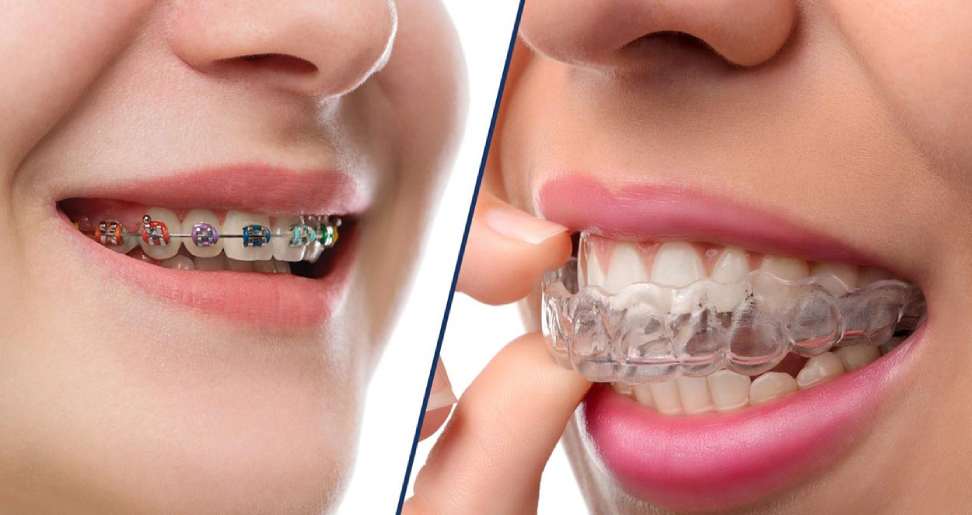Achieving a straighter smile often involves choosing between two primary orthodontic treatments: Invisalign and dental braces. Each option offers distinct advantages along with all types of considerations, catering to different preferences and orthodontic needs. Understanding the differences between invisalign and dental braces can help individuals make an informed decision about their orthodontic treatment.
Invisalign: The Clear Alternative
What is Invisalign?
Invisalign is a modern orthodontic treatment procedure that can be used as a series of clear, removable aligners that gradually straighten the teeth. These aligners are custom-made using 3D imaging technology to fit snugly over the teeth and apply gentle pressure to move them into the desired position.
Advantages of Invisalign:
- Aesthetic Appeal: One of the significant advantages of Invisalign. It is a virtually invisible appearance. The clear aligners are discreet, making them a popular choice for individuals who prefer a more subtle orthodontic treatment.
- Removable Convenience: Unlike traditional braces, Invisalign aligners are removable. This feature allows for easier maintenance of oral hygiene as patients can brush and floss their teeth normally without brackets and wires obstructing cleaning efforts.
- Comfort: Invisalign aligners are smooth and custom-fit, minimizing discomfort often associated with traditional braces. There are no wires to tighten, reducing the likelihood of mouth irritation.
- Dietary Freedom: Since Invisalign aligners are removable, patients can continue to enjoy their favorite foods without restrictions. There’s no need to avoid certain foods that could get stuck in or damage traditional braces.
- Predictable Results: Treatment with Invisalign typically involves a series of aligners that are changed every few weeks as teeth gradually move into alignment. This process is planned in advance using advanced computer imaging, providing a clear timeline and outcome expectations.
Dental Braces: Time-Tested Effectiveness
What are Dental Braces?
Dental braces consist of metal brackets bonded to the teeth and connected by wires that apply constant pressure to gradually move teeth into the desired position. Traditional braces have evolved over the years, with options including ceramic braces that blend with the teeth or lingual braces that are placed on the inside surface of the teeth.
Advantages of Dental Braces:
- Effective for Complex Cases: Dental braces are highly effective for correcting more severe orthodontic issues, such as rotations, vertical discrepancies, and complex bite problems. They offer precise control over tooth movement, allowing orthodontists to achieve comprehensive results.
- Affordability: Traditional braces are often more cost-effective compared to Invisalign, making them a practical choice for patients looking to achieve straighter teeth within a specified budget.
- No Compliance Issues: Unlike removable aligners, dental braces are fixed onto the teeth throughout the treatment duration. This eliminates concerns about patients forgetting to wear their aligners or losing them.
- Predictable Outcomes: Orthodontists have extensive experience and a long history of successful cases with dental braces. The treatment process is well-established and reliable for achieving desired results.
- Suitable for All Ages: Dental braces are suitable for patients of all ages, from children to adults, making them a versatile option for orthodontic treatment.
Choosing the Right Option
When deciding between Invisalign and dental braces, several factors should be considered:
- Visibility Preferences: If maintaining a discreet appearance during treatment is important, Invisalign may be the preferred choice due to its clear aligners.
- Orthodontic Needs: Patients with complex orthodontic issues may benefit more from the precise control and effectiveness of dental braces.
- Lifestyle Considerations: Individuals who prefer the flexibility of removing their orthodontic appliance for eating and cleaning may find Invisalign aligners more convenient.
- Budget: Cost considerations play a role in decision-making, as traditional braces are generally more cost-effective compared to Invisalign.
- Orthodontist Recommendation: Ultimately, consulting with an experienced orthodontist is crucial. They can assess your specific orthodontic needs, lifestyle factors, and preferences to recommend the most suitable treatment option.
Both Invisalign and dental braces offer effective solutions for achieving a straighter, more confident smile. By understanding the unique benefits of each option, individuals can make an informed decision that aligns with their orthodontic goals and lifestyle preferences. Whether opting for the clear, removable aligners of Invisalign or the time-tested effectiveness of dental braces, committing to orthodontic treatment can lead to long-term dental health and aesthetic satisfaction.
Read Also:
- Man Arrested For Parachuting His Way Off Of Paris’s Eiffel Tower
- 70 Delhi Govt School’s Students Fall Ill Right After ‘eating mid-day meal
- Carlsen Defeated Praggnanandhaa In Tie-Breaks To Win The Chess World Cup

